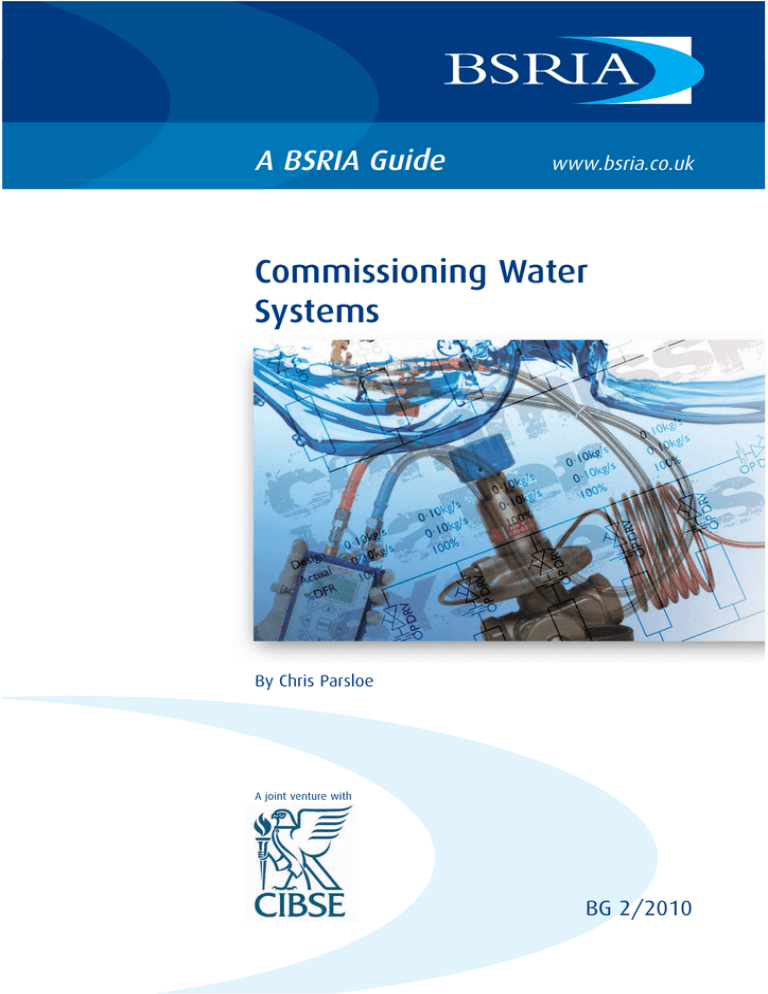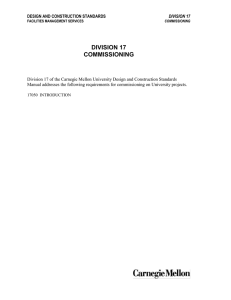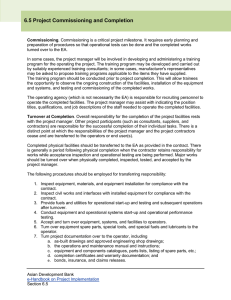
A BSRIA Guide
www.bsria.co.uk
Commissioning Water
Systems
By Chris Parsloe
A joint venture with
BG 2/2010
Acknowledgements
The first edition of Commissioning of Water Systems in Buildings was produced by BSRIA (AG 2/89) as
part of a research project in 1989, under the sponsorship of the Department of the Environment,
Construction Directorate, and under the direction of an industry steering group.
This new fully-revised edition has been compiled with the help of a joint CIBSE/BSRIA industry
steering group under the chairmanship of Bryan Franklin. The steering group members were:
AECOM
Arup
Ashford Environmental Services
Balfour Beatty Engineering Services
Banyards
Barfield
Belimo
Burgess Group
Commissioning Specialists Association
Commtech
Crane
Crown House
Danfoss
End Systems
Frese
Raxcrest
SAV
SES
Siemens Building Technologies
Sutton
Tour and Andersson
Wates Interiors
Mike Campbell
Terry Dix
Roger Carlin
Peter Davey
Nick Till
Peter Barrett
Luke Collier
George Moss
John Coppin
Nick Ward
Andy Lucas
Malcolm Moorby
Paul Wightman
Brian Townsend
Matthew Dunk
Terry Dodge
Lars Fabricius
Chris Driscoll
Gerry McGilley
Bill McCluskey
Peter Rees
Lee Hansard
BSRIA acknowledges the very significant contribution made by all the steering group members, but
the responsibility for the document remains with BSRIA.
We would like to thank our author, Chris Parsloe, of Parsloe Consulting, for working with the
steering group to produce the guide and Ruth Radburn of BSRIA for design and production. Our
thanks also go to Hywel Davies and Claire Ruston of CIBSE and Anne King of BSRIA who managed
the consultation process, Richard Tudor of WSP Buildings Limited and Keith Horsley of Hoare Lea
Consulting Engineers for reviewing the book, Alan Gilbert of BSRIA Instrument Solutions for
information on instrumentation and all those who contributed photographs for the Guide.
Electronic copies of the proformas are available from www.bsria.co.uk/goto/watercommissioning.
This publication has been printed on Nine Lives Silk recycled paper, which is manufactured from
100% recycled fibre.
All rights reserved. No part of this publication may be reproduced, stored in a retrieval system, or
transmitted in any form or by any means electronic or mechanical including photocopying,
recording or otherwise without prior written permission of the publisher.
©BSRIA BG 2/2010
September 2010
ISBN 978 0 86022 689 5
Printed by ImageData Ltd
COMMISSIONING WATER SYSTEMS
© BSRIA BG 2/2010
1
Preface
Bryan Franklin
Commissioning is the ultimate test for proving the design and installation of building engineering services
in practice and is a requirement of Part L of the Building Regulations. Commissioning of water systems is
critical in achieving the safe, energy and carbon efficient and effective operation of hydronic systems
through correct circuit balancing of distribution and components. Proper commissioning enables
engineering systems to operate at optimum performance and provide the building users with good quality
internal environments.
Designers and clients are encouraged to consider the requirements for commissioning at an early stage of
the design of a project to ensure the statically completed installations may be fully checked and proved.
This Guide has been revised to ensure the most recent knowledge and experience for commissioning
building engineering services is made available to practising engineers. The decision to revise the Guide
resulted from meeting of commissioning practitioners to consider whether this and the related CIBSE Code
W 2003 should be updated.
Key issues identified were:
x
x
difficulties in commissioning heating systems with low flow rates, particularly fan coil units
the need to review and clarify the tolerance tables in the light of recent experiences.
This guidance is based on BSRIA Application Guide AG 2/89.3. It recognises the need to preserve much of
the current format and arrangement enabling it to be used for new and ongoing projects without the need
to modify existing contract document or procedures.
The guide describes how to commission, and complements the CIBSE Commissioning Code W which
describes the requirements for commissioning.
Practising engineers should not necessarily refer in specifications to the document as a whole but may
incorporate particular references from the code and guide in the contract documents thereby providing
bespoke definitions applicable to the functional content of the project.
The preparation of this code has been the responsibility of a Joint Steering Committee enabling the CIBSE
and BSRIA documents to be fully co-ordinated and integrated. We thank all of the members of the
committee for their commitment and expertise.
Bryan Franklin
Chairman, Joint CIBSE/BSRIA Steering Committee.
2
COMMISSIONING WATER SYSTEMS
© BSRIA BG 2/2010
Contents
Definitions
6
Abbreviations
7
List of symbols
8
1
Introduction
1.1 Building Regulations Part l
1.2 Guide content
9
9
9
2
Design for commissionability
2.1 Commissioning specification
2.2 Pipe system layout
2.3 Pipe sizing
2.4 Pump sizing
2.5 Commissioning devices
2.6 Ultra low flow rates
2.7 Pre-commission cleaning provisions
2.8 Venting provisions
2.9 De-aeration
2.10 Provisions for measuring pressure
2.11 Tolerances
10
10
12
12
13
13
14
14
15
15
16
16
3
Commissioning devices
3.1 Regulating valves
3.2 Flow measurement principles
3.3 Flow measurement devices (FMDs)
3.4 Improvised flow measurement
3.5 Combined flow measurement and regulation devices
3.6 Constant flow regulators (CFRs)
3.7 Differential pressure control valves (DPCVs)
3.8 Pressure independent control valves (PICVs)
3.9 Guidelines for locating commissioning devices
20
22
24
25
26
28
29
30
32
34
4
The installation of commissionable systems
4.1 Organisation and planning
4.2 Installation issues affecting commissionaibility
4.3 Housekeeping
4.4 Workmanship
4.5 Installation of commissioning devices
4.6 Accessibility
4.7 Draining provisions
4.8 Venting
4.9 Installation inspections
4.10 Preparation for commissioning
35
35
36
36
36
37
37
38
38
40
40
COMMISSIONING WATER SYSTEMS
© BSRIA BG 2/2010
3
5
Site test instruments
5.1 Rotational speed measurement
5.2 Voltage and current measurement
5.3 Flow measurement
5.4 Pressure measurement
5.5 BSRIA recommended test kit
41
41
42
43
46
46
6
Commissioning procedures
6.1 Organisation and planning
6.2 Setting to work
6.3 Full system scan
6.4 Regulation procedure
6.5 Proportional balancing
6.6 Flow setting
6.7 Flow measurement accuracy
47
47
48
49
49
49
53
54
7
Example method statements
7.1 Primary circuits
7.2 Constant flow secondary circuits
7.3 Variable flow secondary circuits
7.4 Setting of total flow rate from the pump
55
55
56
61
67
8
Reporting and documentation
8.1 Reporting
8.2 Documentation
8.3 Example pro formas
73
73
73
74
References
4
COMMISSIONING WATER SYSTEMS
© BSRIA BG 2/2010
82
Tables
Table 1:
Table 2:
Recommended range of maximum water velocities
Suggested tolerances for flow regulation in heating system as stated in
CIBSE Code W: 2010
Table 3: Suggested tolerances for flow regulation in chilled water systems as stated in
CIBSE Code W: 2010
Table 4: Commissioning device, terminologies and functions
Table 5: Valve applications
Table 6: Minimum straight lengths recommended upstream and downstream of flow
measurement devices
Table 7: BSRIA-recommended test kit
13
17
17
21
34
37
46
Figures
Figure 1: Heat transfer sensitivity for heating and cooling coils
Figure 2: Double-regulating globe valves
Figure 3: Double-regulating butterfly valve
Figure 4: Typical fixed-orifice flow measurement devices
Figure 5: Flow rate measurements using fixed resistances
Figure 6: Improvised flow rate measurements in circuits with PICVs
Figure 7: Flow rate measurements in circuits fed from manifolds
Figure 8: Typical fixed-orifice double-regulating valves
Figure 9: Typical variable orifice double regulating valves
Figure 10: Cartridge type constant flow regulators
Figure 11: Differential pressure control valves
Figure 12: Pressure independent control valves
Figure 13: Mercury manometer
Figure 14: Digital differential pressure and flow rate instrument
Figure 15: The basis of proportional balancing
Figure 16: Typical primary circuit arrangement
Figure 17: A constant flow fan coil system with FODRVs
Figure 18: A constant flow fan coil system with CFRs
Figure 19: A variable flow radiator system with DPCVs
Figure 20: A variable flow fan coil system with DPCVs
Figure 21: A variable flow fan coil system with PICVs
19
23
23
25
27
27
27
28
29
30
31
33
45
45
50
55
57
60
62
64
66
COMMISSIONING WATER SYSTEMS
© BSRIA BG 2/2010
5
Definitions
6
Cavitation
The localised vaporisation of a liquid caused when the absolute pressure of
the liquid falls to a value approaching its vapour pressure.
Chemical cleaning
The removal of deposits such as scale, corrosion and biofilm from the
internal surfaces of pipework by treatment with chemicals and in accordance
with a formal procedure.
Commissionable system
A system designed, installed and prepared to specified requirements in such
a manner as to enable commissioning to be carried out.
Commissionability
The ability of a system to be commissioned satisfactorily.
Commissioning
The advancement of an installation from the state of static completion to full
working order to specified requirements. For pipework distribution systems
it includes the setting to work of an installation and the regulation of flow
rates.
Commissioning management
The planning, organisation, co-ordination and control of commissioning
activities.
Commissioning management
organisation
The firm (or person) appointed to manage the commissioning process, being
responsible for overall planning, supervision and witnessing of the results of
the integrated commissioning of all installed building services systems.
Commissioning specialist
The firm (or person) appointed to carry out specified duties in connection
with the commissioning of the engineering services.
Commissioning specification
The document (or sub-section of the design specification) that prescribes
the detailed objectives and requirements for commissioning.
Note: the specification must refer to drawings, schedules and relevant parts
of the codes, manuals, guides and other standards.
Designer
The organisation (firm or persons) responsible for the design of the water
services systems that are to be commissioned. Depending on the method of
procurement this may be one or more organisation. In many instances the
design intent of the water services systems may be set out by one
organisation, with the final selection of some, or all, of the individual
components (main plant, pumps, terminal equipment, control and regulating
valves) by another organisation. Where this is the case the final system flow
rates should be provided by the organisation that has selected the
components, however this responsibility should be clearly set out in the
contract documents.
Design criteria
The specified performance of the system expressed as a numerical quantity
together with allowable tolerances.
Diversity
The ratio between the anticipated peak heating or cooling load demand
from a system, and the summated maximum heating or cooling capacities of
the installed equipment.
Flushing
The washing out of an installation with water to a specified procedure in
order to remove manufacturing and construction debris (as per BSRIA AG
1/2001.1)
Installation
A system placed in position as required by the design or specification.
Pre-commissioning
Specified systematic checking of a completed installation to confirm its state
of readiness for commissioning.
Note: Pre-commissioning is a post-installation completion activity.
Pressure and leakage testing
The measurement and recording of a specified pressure retention or loss
within a system or system component.
COMMISSIONING WATER SYSTEMS
© BSRIA BG 2/2010
Proportional balancing
The process of bringing the fluid flow rates throughout a distribution system
into balance with one another, in their correct proportions and within
tolerances specified by the designer.
Regulating
The process of adjusting the flow rates of a fluid in a distribution system to
achieve the design flow rates within the tolerances specified by the designer.
Setting to work
The process of setting a static system into operation.
Static completion
The state of a system when it is installed in accordance with the drawings
and specification, i.e. being clean and ready for setting to work. In the case
of water systems this includes flushing, cleaning, pressure and leakage
testing, filling and venting.
System
A set of connected components for heating, cooling, ventilation or air
conditioning consisting of plant, distribution ducting, piping and terminal
units and arrangements to control their operation.
Tolerance
The permissible range of variation from the specified design value.
Water treatment specialist
The firm (or person) appointed to carry out specified duties in connection
with the flushing, chemical cleaning and water treatment of pipework
systems.
Witnessing authority
The firm or person that may sometimes be appointed to witness the results
of commissioning, and to verify that results obtained comply with the
requirements of the design criteria and commissioning specification.
Abbreviations
%DFR
Percentage of design flow rate
AHU
Air handling unit
CFR
Constant flow regulator
DRV
Double regulating valve
DPCV
Differential pressure control valve
FMD
Flow measurement device
FODRV
Fixed orifice double regulating valve
PICV
Pressure independent control valve
TRV
Thermostatic radiator valve
VODRV
Variable orifice double regulating valve
COMMISSIONING WATER SYSTEMS
© BSRIA BG 2/2010
7
List of symbols
8
COMMISSIONING WATER SYSTEMS
© BSRIA BG 2/2010
1 Introduction
This Guide explains how to commission water pipework distribution systems in buildings. The
commissioning process mainly comprises the setting to work of the system pumps and the regulation
(or proportional balancing) of system flow rates.
The procedures set out in this guide, if undertaken, should achieve compliance with the requirements of
(1)
CIBSE Code W Water Distribution Systems , which sets out the standards of good practice which are
generally accepted within the building services industry.
The emphasis of this guide is on heating and cooling systems for buildings (chiefly non dwellings)
although it may also be applied to other types of water distribution systems. The guide is equally
applicable to new-build and retrofit applications and is independent of the scale of the system.
Compliance with the requirements of this guide does not confer immunity from, nor imply adherence
to, relevant statutory and legal requirements.
1.1
BUILDING REGULATIONS PART L
(2)
Part L of the Building Regulations in England and Wales requires that reasonable provision is made for
the conservation of fuel and power in buildings by providing and commissioning energy efficient fixed
building services with effective controls.
The approved procedure by which compliance with Part L can be demonstrated for non dwellings is
(3)
that set out in CIBSE Code M Commissioning Management , and, for pipework distribution systems, its
(1)
sub-referenced document CIBSE Code W Water Distribution Systems .
1.2
GUIDE CONTENT
Technical guidance is sub-divided into the following section headings:
x
Section 2: Design for commissionability
x
Section 3: Commissioning devices
x
Section 4: The installation of commissionable systems
x
Section 5: Site test instruments
x
Section 6: Commissioning procedures
x
Section 7: Example method statements
x
Section 8: Reporting and documentation
Sections 2 and 4 of the guide are particularly aimed at system designers and installers. Unless
commissioning is properly considered during both the design and installation stages of a project, it may
(1)
not be possible to meet the requirements of CIBSE Code W .
Section 3 provides a summary of the main commissioning devices available at the time of writing.
Sections 5, 6, 7 and 8 are intended as guidance for commissioning specialists employed to undertake
commissioning activities.
COMMISSIONING WATER SYSTEMS
© BSRIA BG 2/2010
9
2 Design for commissionability
Designers and project managers should address their attention to commissioning and the effective
management of the process as soon as possible after embarking on the scheme design stage.
Guidance on the management of the commissioning process is provided in the following publications:
(3)
x
CIBSE Code M, Commissioning Management as required by the Approved Documents L2A and L2B
(2)
of the Building Regulations
x
BSRIA Guide BG 1/2009, Building Services Job Book
x
BSRIA Guide BG 6/2009, A Design Framework for Building Services
x
BSRIA Guide BG 8/2009, Model Commissioning Plan , cited as a way of documenting the process
(2)
in the Approved Documents of the Building Regulations
x
BSRIA Guide BG 11/2010 Commissioning Job Book .
(4)
(5)
(6)
(7)
The ease with which the flow rates in a pipework system can be regulated is often dependent on the
level of planning that occurs at the design stage. The objective should be to design a commissionable
system that is easy to regulate and trouble-free in operation.
Section 2.1 explains how to specify the process and Section 2.2 – 2.11 explain the main issues that
need to be considered during design.
2.1
COMMISSIONING SPECIFICATION
To enable a water distribution system to be successfully commissioned, the designer must provide
adequate information, documented in the form of drawings, schedules and specification clauses. These
documents are collectively known as the “commissioning specification”.
The commissioning specification for pipework systems should be developed by the designer to
comprise:
10
1.
The scope of the works i.e. the systems to be commissioned, their function and intended
operation, and an explanation of their inter-relationships with other engineering systems.
2.
The setting out of the responsibilities of the various parties (e.g. client, design team, main
or managing contractor, installation contractor and commissioning specialist). BSRIA Guide
(5)
BG6/2009 A Design Framework for Building Services , and BSRIA Guide BG8/2009, Model
(6)
Commissioning Plan give advice on the allocation of responsibilities for commissioning
activities.
3.
The technical requirements of the commissioning work including:
x
the standards with which the works should comply (e.g. CIBSE Codes and BSRIA
guides)
x
the limiting flow measurement tolerances for flow measurement test results (as advised in
Section 2.11 of this guide)
x
the reporting procedures required for demonstrating the commissioning results
x
the witnessing procedures to be observed.
COMMISSIONING WATER SYSTEMS
© BSRIA BG 2/2010


